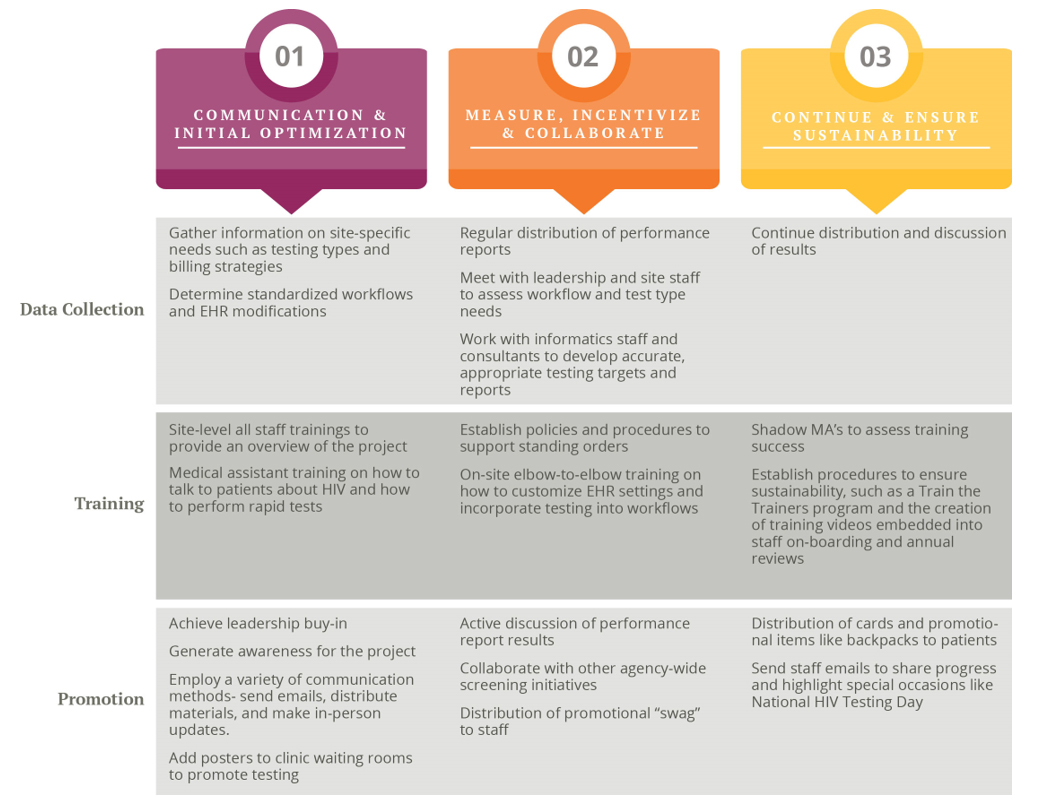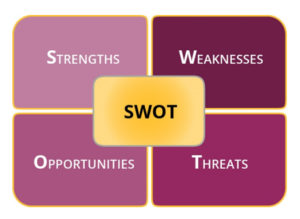Create an Implementation Plan
We knew the scope of our grant timeline would end December 31, 2017. In order to meet our greater deadline, we started a strategic plan based on our knowledge of the system, what changes were already underway at an agency level, and the challenges we knew would require more deliberation to successfully achieve.
– HIV Testing Training Specialist / Project Champion
Start with the Big Picture
Once you’ve laid the groundwork, you should have a list (a mental one at least) of all your agency’s competing priorities, projects, and goals, with a general idea of how a new HIV testing program fits into these other activities. Now is the time to start pulling together specifics. What specific committees can help advance HIV testing throughout the agency? Which other projects (EHR optimization, quality metrics, etc.) might be willing to use HIV testing as an example or test case? How does this effort harmonize with the agency’s quality improvement structure or training department calendar? Collect details on the schedules of these other activities and strategize about where and when HIV testing might fit into these other plans.
Leveraging these external opportunities can provide an initial framework for a project management outline or timeline. From there, you can begin to add all the other details on the activities needed to achieve universal HIV testing.
Incorporate a Structured Approach
Taking advantage of areas of overlap is a good start, but you’ll want to take a structured approach to filling in all the details. A project of this scope involves so many individual changes across so many different levels of the organization that it needs to be planned out in detail. [See sample Webinar Slides under Resources.] Start with your larger project goals and deadlines first. For example, at Santa Rosa Community Health, we divided the project into three distinct phases and added an additional layer of structure to each phase by identifying three key areas of effort:

Once you have an overall timeline worked out, you can plan out all the required smaller steps. Implementing the project at multiple sites imposes additional complexity. Some activities such as changes to policies and procedures may be easily implemented organization wide, but each site will likely require separate timelines for rolling out trainings and working out logistics. The good news is that different areas of effort can be tackled simultaneously. For example, staff trainings can introduce the project at the same time EHR workflows are developed, and data reports can be configured at the same time staff are trained on workflow adjustments.
Tools such as Gantt charts, software such as Microsoft Projects, or on-line applications such as Smartsheet or Basecamp are highly recommended ways to track all the moving parts. [See Sample Gantt chart under Resources.] You don’t need to purchase fancy software. A web search for “free Gantt charts” yields plenty of downloadable Excel options.
Set Realistic Goals and Timelines
When building your timeline, it’s important to have realistic expectations for how much and how quickly things will move. While it’s great to set a lofty, aspirational overall goal, breaking things down into smaller, more achievable steps can help maintain engagement and motivation.
Think about the strengths and weaknesses of your organization and its capacity to implement universal HIV testing. You can even do a SWOT (Strengths, Weaknesses, Opportunities and Threats) analysis to make sure you’ve thought through not just how to implement the project, but how much time each component will take. Each site may have its own strengths and weaknesses to consider. For example, screening high school students for HIV at a school-based clinic carries very different challenges from testing homeless or mentally ill patients in a primary care setting.

This should all lead to an impressively detailed plan for carrying out the project. Even so, you’ll want to stay flexible as deadlines are missed and all the details in your plan need to be rethought and rescheduled.
Include Ongoing Evaluation
Program evaluation activities are too easily skipped, an understandable consequence given the constraints on financial resources and available staff time in a clinic environment. But planning basic quantitative and qualitative evaluation of the project along the way can provide invaluable feedback. You might identify problems early on that would otherwise go undetected, and you might get some great suggestions for how to improve implementation.
Evaluation activities might include:
- Quick training surveys. Pre- and post-training surveys completed by attendees can assess how much attendees learned, what they found helpful about the training, and what they would also like to learn. Keep them short to encourage completion, and keep them anonymous to encourage honest responses.
- A simple on-line staff survey using a tool like SurveyMonkey can automatically compile results. [See sample On-line Staff Survey.] Including a drawing for a few gift cards to a favored local restaurant or coffee shop can encourage a higher response rate. You might conduct a survey 3 – 6 months after implementation has begun. You can always run a second one later on if you want to see if additional changes have occurred.


- Adding a question or two to the organization’s standard patient satisfaction survey. Getting a question permanently added to the survey can serve as a small step towards sustainability.
- Interviewing staff or patients. You might be surprised by how much helpful qualitative information can be obtained from interviewing a small number of people. Consider speaking with leadership about how they view the project and its place in the organization, with clinicians and medical assistants about their changing knowledge and attitudes and the project’s effects on workflow, or with patients about how they understand the need for HIV testing and their comfort with the way it was presented to them. [See sample Interview Guides under Resources.] With staff, it may be as simple as meeting them over lunch. With patients, it’s important to assure their anonymity so their health care won’t be impacted by their responses to your questions.
As always, be realistic about how much you can accomplish. Start small and focus on evaluating areas 1) that are most important to the project’s success or 2) that you are worried aren’t going as well as they might. Once you start gaining valuable insights through your evaluation activities, you may decide to do even more. Your evaluation activities may serve as a model for other projects throughout the organization.

Resources:
HIV Screening Project Implementation Webinar Slides: Webinar slides from an early project meeting showing project phases (.pdf)
Generic Gantt Project Planner: Sample generic Gantt chart template (.xlsx)
Sample staff survey about HIV testing, including feedback on trainings, changes in knowledge and beliefs, overall success of screening efforts and barriers to screening, patient response, and usefulness of promotional materials. Designed to be loaded into SurveyMonkey (.pdf )
Leadership Interview Form: Sample questions for conducting interviews with clinic leaders (.pdf)
![$logo['alt']](https://srhealth.org/wp-content/uploads/2017/03/srch-logo-1.png)